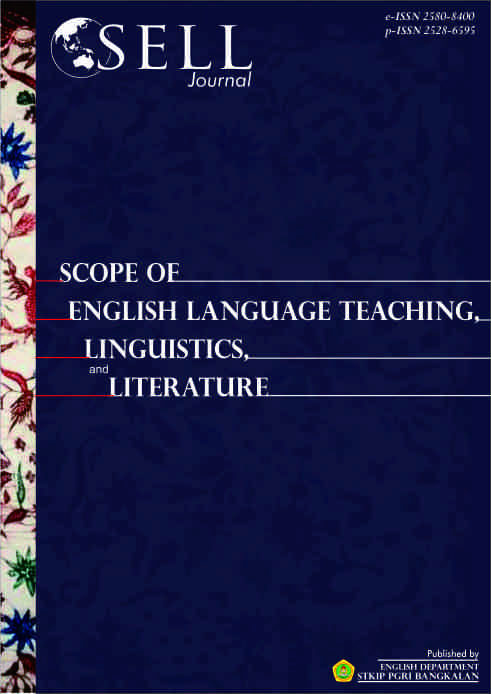The Factors of Speaking Difficulties in New Students' of English Education Department
DOI:
https://doi.org/10.31597/sl.v8i2.983Keywords:
speaking, speaking factors of difficulties, English department new studentsAbstract
Speaking problems is a phenomenon of new students that we see today some new students are used to using their mother tongue, they tend to use their mother tongue because they have been familiar since childhood, so it is easier to talk to each other. They feel they lack mastery of foreign languages so they lack motivation. They are not so used to using foreign languages. From the explanation above, related to the theory of (Penny Ur, 1996 in Fitri Nurhadiah, 2019) there are four factors that cause students' difficulties in speaking such as barriers, nothing to say, low or uneven participation, and the use of mother tongue. Here, the author conducted research by using qualitative approach and implement observation and interview to get the data. there are 3 factors that cause difficulties for new students in speaking, namely performance conditions, learning environment, speech problems such as barriers, nothing to say, low or uneven participation, and use of mother tongue.
References
Evidence-Based Nursing, 21(3), 63–64. https://doi.org/10.1136/eb-2018102939
Cohen, L., Manion, L., Lecturer, P., Morrison, K., & Lecturer, S. (n.d.). Research Methods in Education.
Manurung, Y. H. (2020). Analysis on Students’ English Speaking Performance At University of Muhammadiyah Sumatera Utara. Vision, 16(2), 35–44. https://doi.org/10.30829/vis.v16i2.809
Rashid, Y., Rashid, A., Warraich, M. A., Sabir, S. S., & Waseem, A. (2019). Case Study Method: A Step-by-Step Guide for Business Researchers.
International Journal of Qualitative Methods, 18, 1–13. https://doi.org/10.1177/1609406919862424
Rodrigo Garcia Motta, Angélica Link, Viviane Aparecida Bussolaro, G. de N. J.,
Palmeira, G., Riet-Correa, F., Moojen, V., Roehe, P. M., Weiblen, R.,
Batista, J. S., Bezerra, F. S. B., Lira, R. A., Carvalho, J. R. G., Neto, A. M.
R., Petri, A. A., Teixeira, M. M. G., Molossi, F. A., de Cecco, B. S., Henker,
L. C., Vargas, T. P., Lorenzett, M. P., Bianchi, M. V., … Alfieri, A. A.
(2021). No 主観的健康感を中心とした在宅高齢者における 健康関連指
標に関する共分散構造分析Title. Pesquisa Veterinaria Brasileira, 26(2),
173–180. http://www.ufrgs.br/actavet/31-1/artigo552.pdf
Safitri, H., Rafli, Z., & Dewanti, R. (2020). Improving Students’ Speaking Skills through Task-Based Learning: An Action Research at the English
Bandjarjani, Wahju. 2011, Pendidikan dan Latihan Profesi Guru. Univ. PGRI ADI BUANA, Surabaya.
Bogdan. C. Robert, Sari Knopp Biklen. 1992. Qualitative Research for Education.
Brown. H. Douglas. 2001. Teaching by Principles. Pearson ESL.
Hadfield, Jill. 1987, Advanced Communication Games, Qarry Bay, Hongkong.
Isti, Wiji Lestari. 2011. A Study Of The Student’s Oral Proficiency By Using The Guessing Games In The First Grade At SMPN 3 Bangkalan. Unpublished Thesis, STKIP PGRI BANGKALAN.
Jack, C. Richards and Willy A. Renandya. 2002. Methodology in Language Teaching. Cambridge University, USA.
Lindsay, Cora with Paul Knight. 2006. Learning and Teaching English. Oxford: University Press.
Downloads
Published
How to Cite
Issue
Section
License
1. Copyright of this journal is possession of Editorial Board and Journal Manager, by the knowledge of author, whilst the moral right of the publication belongs to the author.
2. Legal formal aspect of journal publication accessibility refers to Creative Commons Atribution-ShareAlike (CC BY-SA), implies that this license lets others remix, adapt, and build upon your work even for commercial purposes, as long as they credit you and license their new creations under the identical terms. This license is often compared to “copyleft” free and open source software licenses.
3. Every publications (printed/electronic) are open access for educational purposes, research, and library. Other that the aims mentioned above, editorial board is not responsible for copyright violation















